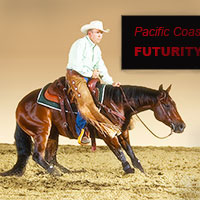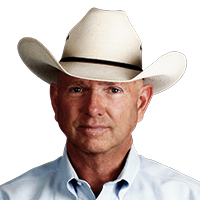
Showing at the PCCHA futurity
with a 3 year old filly.
The Top Five Myths About
Competition Cutting Horses
By Larry Trocha
A pro’s advice about cutting horses
and cutting horse prospects.
Watch the VIDEOS that showcase
how to train horses on cattle.
Dear Friend and Horseman,
Welcome to another Horse Training Tips Insider.
During my career as a professional
horse trainer, I’ve heard horse owners tell all kinds of reasons why
they think their horse could be a winner in the cutting arena.
Unfortunately, when it comes to cow horses, a lot of folks are
misinformed as to what is fact and what is fiction.
And of course, any time you’re talking
about horses, there are always exceptions to the rule. But, for the most
part… Here are a few of the most common myths.
Myth #1.
My colt should really make a great cutter.
Whenever our “dog” goes into
the pasture, the colt chases him around and works him just like cutting
a cow. (For the word “dog” you could substitute “goat”, “another horse”,
“a person” or “whatever”).
I wouldn’t enter the colt up at the Fort Worth futurity
just yet.
Here’s the usually disappointing truth…
The dog isn’t a cow… The colt is doing this without
a rider on his back… And most importantly, the colt is doing this
activity without any rules he has to adhere to, such as form and style
of working.
In reality, there are a lot of colts that like to have fun
chasing something around. It’s play, pure and simple.
It’s another thing entirely for a colt to become a
cutter.
First of all, the newness of working the cow will wear off and
the training will eventually become work. When the colt finds out he has
to work the cow with precision, form and style, he might not want to do
it.
That’s why it’s so important your cutting prospect
is bred to be a cutter. If the sire and dam have the attributes to be
successful in the cutting arena, the colt has a lot better chance of
being successful also.
Myth #2.
My colt should make a great cutter.
I rode him out to gather some cattle
for the first time and he was really good. He wasn’t bothered or
scared by the cattle and acted like it was nothing new at all.
Like I said earlier, there are always exceptions to
the rule. But, when a colt doesn’t show much of a reaction to a cow it
usually means he’s not going to be a good one.
Every top cutting horse
I’ve ever trained, either was fearful of the cow and wanted to keep a
safe distance from it or was aggressive towards the cow and wanted to
dominate it.
The 1990 NCHA futurity champion, Millie Montana,
was the dominant kind.
The very first time I worked her on a cow, she
wanted to take charge. Her head went down, her ears went back and
everything about her body language told the cow that she was the boss.
The great NCHA world champion mare, Doc N Missy,
was the exact opposite.
She was in my string when I was working for Gene Suiter in Arizona. I’ll never forget her reaction the first time I
introduced her to a cow. She was so scared of it, she literally tried to
jump out of the arena.
The cow would be 150 feet away down at the other
end of the arena, but that was too close for comfort for her. It
actually took a couple months before she got confident enough to move
toward the cow.
Myth #3.
My colt should make a great cutter.
He is 99% foundation bred. His
bloodlines trace back to Wimpy P1 five times on the top side and three
times on the bottom. Those old foundation horses were real cow ponies.
Here’s the actual facts…
Many of the old-time foundation
Quarter Horses of the 1940s and 1950s were not good cutting horses (compared to today’s standards).
Most were either common,
every-day ranch horses or competition race horses.
And yes, there were exceptions to the rule… horses like Poco Lena… but those kind were few and far between.
Now, if you own a foundation bred horse, don’t take
what I’m about to say the wrong way. Our topic here is modern-day
“competition” cutting.
Yes, I’ve ridden plenty of foundation bred
horses that would definitely work a cow.
King, Leo and Three Bars were the most dominant
cutting horse bloodlines. There were a few others too.
But the vast majority of those old foundation
horses can’t compare to our present-day sires when it comes to
consistently producing winning cutting horses on a large scale.
Side Note: The horse industry in general, didn’t start seriously breeding for specialized cutting horse competition until the late 1960s and early 1970s. By the 1980s we had horses that were really bred to cut cattle in the show pen.
That period in time (the 1980s), is considered the start of the modern-day cutting industry. Some of the most INFLUENTIAL horses came out of the 1982 – 1983 NCHA cutting futurities. Horses like Smart Little Lena, Royal Blue Boon etc.
If you go to any of the top cutting trainers
and ask them to describe what it’s like to try to get one of those
old-time
“foundation bred” horses (1940s & 50s) to cut, here is the answer you’ll get 9 out of
10 times:
-
Most don’t have enough cow or intensity to make
it in modern-day cutting competition. -
They’re difficult to train for today’s type of cutting. For example,
they either learn too slow to be ready for the futurity or they want to argue too much. -
If you manage to overcome A and B, it’s still
tough to win because many of them don’t have the athletic ability and
style of modern-day cutting horses. You may find a good one but you’ll do a lot of sifting before you find him.
If you want your colt to be a good cutter, the
least you can do is make sure he comes from bloodlines that produce good
cutters. And yes, there are horses that are exceptions to the rule, but
they are few and far between.
Myth #4.
My colt should make a great cutter.
I’m going to put him in training
with this hot shot trainer for six months and have him shown at the
cutting futurity.
Actually, this is a misconception a lot of people
have about training a cutting horse.
It takes a long time to get a horse
to the point of being “showable” at a contest. To have a colt ready for
a futurity takes a minimum of 16 months of training on cattle.
If the colt is an exceptionally fast learner, you
might get lucky and have him ready in just one year. This means to have
a colt ready to compete in the fall futurities as a 3year old, he needs
to be started on cattle by spring-time of his 2 year old year.
Owners are afraid of starting their colts that
young, fearing injury to the colt from starting him too early.
In reality, a good trainer never works a young colt very hard. The idea is to
give the colt a solid foundation built slowly so there is no stress.
When this is done right, seldom will a colt get hurt.
Myth #5. A new owner usually thinks… “I’m going to buy my first cutting horse and take him to a show next week-end.
I should do pretty well. After all, cutting horses are trained
to work on their own. The rider doesn’t have to do anything but hang on”.
I sure wish it was that simple. It would make my
job as trainer and coach much easier. It’s true, cutting horses are
trained to work on their own. However, the rider has a “big” influence
on how well the horse works.
An inexperienced rider can cause even the best
cutting horse to make mistakes.
The most common ones are… rounding the
turns, missing the stop and being out of sync with the cow. Most new
cutters don’t realize they could ruin their horse if they don’t learn to
ride correctly in a relatively short period of time.
The best plan is to find a knowledgeable coach
that will help you learn to ride your cutter the right way.
If you’re looking for some of the best cutting horse instructional videos,
just click on this link.
That’s all for now. Good luck.
Larry Trocha
Reining & cutting horse trainer,
Larry Trocha
About the author, Larry Trocha
Larry Trocha lives in Acampo, California where he trains horses for the public.
Larry also offers instruction to riders who want to learn reining, cutting or reined cow horse.
You can contact Larry via his website: www.HorseTrainingVideos.com

